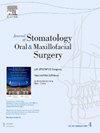利用运输盘牵引成骨技术修复下颌骨缺损时牙齿移动的生物力学分析。
IF 1.8
3区 医学
Q2 DENTISTRY, ORAL SURGERY & MEDICINE
Journal of Stomatology Oral and Maxillofacial Surgery
Pub Date : 2024-11-17
DOI:10.1016/j.jormas.2024.102147
引用次数: 0
摘要
简介:牙齿移动或旋转是使用运输盘牵引成骨(TDDO)修复下颌缺损的并发症之一。然而,其力学原因尚不清楚:为了评估在使用 TDDO 进行下颌骨缺损修复时与牙齿移动相关的生物力学因素,我们采用了一个根据人体下颌骨计算机断层扫描图像创建的有限元模型,以评估牙齿位移以及在承受 TDDO 负载的牙齿上,运输盘导致的牙周韧带上的 Von Mises 应力分布:在运输盘固定臂位移 0.5 毫米的情况下,运输盘上的牙齿远离牵引力。牙周韧带上的应力在远端颈部周围最大(60 千帕)。施加 150 克阻力时,整个牙齿向同一方向移动,隔离线梯度几乎与牙齿长轴平行。虽然应力分布相似,但从几何角度看,应力下降到了 0.117 KPa:讨论:用 TDDO 修复下颌缺损时,运输盘和抗牵引力有助于牙齿的反向运动或旋转,当在同一方向施加拮抗力时,牙齿可能无法移动。本文章由计算机程序翻译,如有差异,请以英文原文为准。
Biomechanical analysis of teeth movement during the repair of mandibular defects using transport disk distraction osteogenesis
Introduction
Teeth movement or rotation is one of the complications of mandibular defect repair using transport disk distraction osteogenesis (TDDO). However, the mechanical reasons are not clearly understood.
Material and methods
To evaluate the biomechanical factors associated with teeth movements during mandibular defect repair with TDDO, a finite element model created from computed tomographic images of the human mandible was adopted to evaluate teeth displacement and the Von Mises stress distribution on the periodontal ligament resulting from the transport disk for teeth subjected to TDDO loading.
Results
Under a displacement of 0.5 mm to the fixed arm of the transport disk, the teeth on the disk moved away from the distraction. The stress on the periodontal ligament was highest (60 KPa) around the distal neck. Upon the application of 150 g of resistance, the entire tooth moved in the same direction and the isoline gradient was almost parallel to the long axis of the tooth. Although the stress was distributed similarly; it decreased to 0.117 KPa geometrically.
Discussion
When mandibular defects are repaired with TDDO, the transport disk and anti-distraction forces contribute to the reversal movement or rotation of the teeth, which may become immobility when antagonistic forces are applied in the same direction.
求助全文
通过发布文献求助,成功后即可免费获取论文全文。
去求助
来源期刊

Journal of Stomatology Oral and Maxillofacial Surgery
Surgery, Dentistry, Oral Surgery and Medicine, Otorhinolaryngology and Facial Plastic Surgery
CiteScore
2.30
自引率
9.10%
发文量
0
审稿时长
23 days
 求助内容:
求助内容: 应助结果提醒方式:
应助结果提醒方式:


